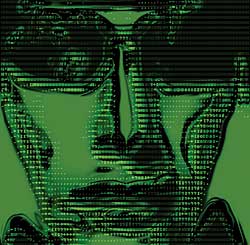
Security's Changing Face
3-D face readers are more accurate and better suited for access control
- By Matthew Bogart
- Nov 05, 2007
 Facial recognition technology has entered a new dimension. It has left the flat world of machine-readable 2-D photographs and entered the world of 3-D. Three-dimensional facial recognition can offer significant advantages over 2-D and is geared toward enterprise access control.
Facial recognition technology has entered a new dimension. It has left the flat world of machine-readable 2-D photographs and entered the world of 3-D. Three-dimensional facial recognition can offer significant advantages over 2-D and is geared toward enterprise access control.
Face recognition has been gaining popularity as a biometric identity verification solution—with annual revenue expected to exceed $1 billion by 2012, according to the International Biometric Group.
Verification and Identification
While 2-D is being used by law enforcement for identification, it is not well suited for verification. Identification involves comparing an image against a database of images to identify a person. In verification solutions, a biometric identifier is compared either to another template called up through a PIN, a smart card or against a small database of other templates. However, because 2-D images are affected by lighting conditions and factors, such as shadows, they are not suitable for access control. In UK trials of biometric passports, only 69 percent of able-bodied volunteers and 48 percent of disabled participants were correctly authenticated. Some 3-D facial recognition systems, however, use their own near-infrared light source, which means they can make accurate matches, even in poor lighting conditions.
And 3-D facial recognition technology has other advantages. It is possible to collect more data points with 3-D—up to 40,000 with some tools—and the types of data points collected are more valuable. While a 2-D system might make a match using the distance between the eyes, 3-D uses the curvature of the forehead. The latter is more useful because it allows 3-D systems to make matches, even if a face changes as a result of a scar or facial swelling due to an accident or a change in weight.
There are two approaches to 3-D facial recognition—stereo and structured light. Stereo 3-D systems create 3-D images by synthesizing two or more 2-D photos. This compute-intensive approach adds an unnecessary layer of complexity to 3-D face matching and, like 2D, is hampered by poor lighting conditions. Structured-light, 3-D face readers, on the other hand, shine an invisible, near-infrared grid-shaped light on a user’s face while a camera takes a picture of the distortions in the grid caused by the face, collecting approximately 40,000 data points.
Access Control
3-D face recognition is designed to make accurate matches, even when the threshold for matches is set very high. This is the exact situation encountered in a deployment by the Regional Transportation District of Denver.
With 85 million passenger trips aboard its light rail, bus, call-n-ride and access-a-ride services each year, the RTD handles millions of dollars in transit fees annually. Like other financial organizations, the RTD treasury needed a top-of-the-line security solution that strictly controls access to its offices and safes. The RTD found what it was looking for in Bioscrypt’s VisionAccess 3-D face readers.
The treasury deployed face readers in conjunction with a Lenel card access system in an award-winning deployment. The treasury entrance also features a mantrap to ensure that only one person can enter at a time.
By adding 3-D face readers to its access control solution, RTD now employes strong authentication solutions. In use, treasury staff pause in front of the reader, where it makes a match with the template stored on their card in less than a second. The initial enrollment process is likewise quick and only takes 6 to 8 seconds.
“Security at the treasury has been increased significantly,” said Don Young, the RTD treasury’s manager. “Bioscrypt’s 3-D face readers are an elegant and simple solution that will present a significant challenge to anyone attempting to gain unauthorized access to the treasury.”
High Standards
Organizations have the ability to set different thresholds for security with any biometric implementation. At a high threshold that raises the number of data points that must match in order for someone to be granted entrance, there will be fewer false accepts—the authorization of unauthorized personnel—but an increase in false rejects—declining access to someone who is actually authorized. At lower thresholds, the number of false accepts increases, while the number of false rejects decreases.
The treasury needed to set its system at a high threshold.
"We have the treasury's security access thresholds set on high because treasury cannot tolerate any false accepts, yet we experience a 99 percent throughput rate. Bioscrypt’s readers are serving us with fast speeds and high accuracy," Young said.
Like other biometric solutions, face recognition uses who a person is, rather than what they know or what they have for identity verification, significantly increasing security without sacrificing convenience. Passwords and PINs—what a person knows—can be stolen, forgotten, lost or lent out. Smart cards, proximity cards and tokens—what a person has—can likewise be stolen, misplaced, forgotten, forged or borrowed. A person’s face or fingerprint—who a person is—however, is always with them and can’t be stolen or copied. Using face recognition alone or in conjunction with another authentication factor for dual- or multi-factor authentication, therefore, significantly increases security.